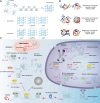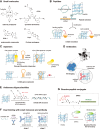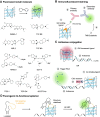RNA G-quadruplex structure targeting and imaging: recent advances and future directions
- PMID: 40473419
- PMCID: PMC12265945
- DOI: 10.1261/rna.080587.125
RNA G-quadruplex structure targeting and imaging: recent advances and future directions
Abstract
RNA guanine (G)-quadruplexes (rG4s) are noncanonical structures formed by G-rich RNA sequences and have been demonstrated to play critical roles in various biological events, including translation, transcription, RNA processing, and other cellular functions. In contrast to DNA G-quadruplexes (dG4s), research on rG4s has been relatively limited until recently. Recent advances in targeting and imaging of rG4s have opened new avenues for understanding their functional significance and therapeutic potential. In this review, we summarize the innovative platforms and tools being developed to target rG4s, highlight the novel and important imaging probes that have been generated and applied for rG4 structure visualization in different biological contexts, and discuss the challenges and perspectives for further advancing these technologies and toolsets to facilitate rG4 targeting and imaging with greater precision and resolution across the Tree of Life. These scientific developments and breakthroughs will enable the discovery of new biological insights regarding rG4s and help decipher their molecular mechanisms and implications for health and disease.
Keywords: G-quadruplex structure; RNA; imaging; nucleic acids; targeting.
© 2025 Wu et al.; Published by Cold Spring Harbor Laboratory Press for the RNA Society.
Figures



References
-
- Andreeva DV, Tikhomirov AS, Shchekotikhin AE. 2021. Ligands of G-quadruplex nucleic acids. Russ Chem Rev 90: 1. 10.1070/rcr4968 - DOI
-
- Ariyo EO, Booy EP, Patel TR, Dzananovic E, McRae EK, Meier M, McEleney K, Stetefeld J, McKenna SA. 2015. Biophysical characterization of G-quadruplex recognition in the PITX1 mRNA by the specificity domain of the helicase RHAU. PLoS One 10: e0144510. 10.1371/journal.pone.0144510 - DOI - PMC - PubMed
Publication types
MeSH terms
Substances
LinkOut - more resources
Full Text Sources
